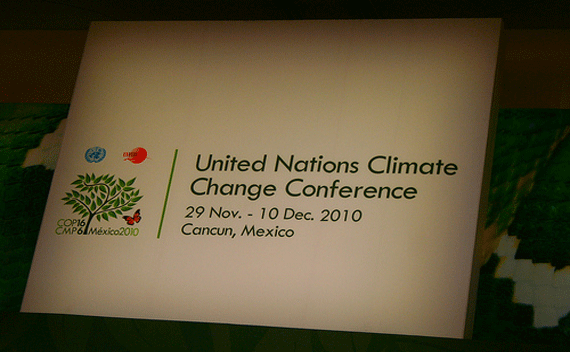Solving Kyoto in Cancun
More on:
 This past April, when I launched this blog, my first public post was titled “Kyoto and Zombies”. As I sit at the Cancun climate talks writing my hundredth one, it’s hard not to marvel at how far we haven’t come.
This past April, when I launched this blog, my first public post was titled “Kyoto and Zombies”. As I sit at the Cancun climate talks writing my hundredth one, it’s hard not to marvel at how far we haven’t come.
Here’s what that first post said:
“Perhaps the biggest surprise of the Copenhagen summit was the central role occupied by Kyoto…. [Recent events are] a reminder that Kyoto lives, despite previous signs of its death. It’s important that we avoid last year’s mistake of neglecting it. But it’s not clear to me that anyone has a good idea of what we should actually do.”
Well, we’ve got three days left in Cancun, and Kyoto is still center stage. Moreover, there’s still no one (myself included) who has a good idea of what we should do.
This year’s conflict flared up early in the talks when Japan loudly announced that it wouldn’t accept new Kyoto targets. There’s been a lot of puzzlement here over why it did that, but I think the explanation is pretty simple. First, while many who push to continue Kyoto do so disingenuously (knowing full well that Japan and much of the EU aren’t game), others simply haven’t accepted that Kyoto as we know it is done. Japan hoped, through its action, to shock those people to reality. Second, Japanese policymakers have long been terrified by the possibility that the U.S. and China might strike their own non-binding deal, leaving them to be bludgeoned into Kyoto II by the Europeans. Last week’s move was preemptive defense.
Not all the blame (or even most of it) can be laid on Japan, of course, though many here are certainly inclined to try. The big developing countries, led by India and China, insisted from the beginning that new Kyoto commitments were a prerequisite for action in the areas the United States cares about, most notably transparency. That ensured that Kyoto would play a central role in the current talks.
 So where do we go now? Some have proposed a two-year extension of the current commitment period, which ends in 2012, but I don’t see how that solves the fundamental problem: the EU and Japan don’t want legal commitments unless others take them too, and others aren’t ready to do that. (The much-discussed Reuters story from Monday afternoon that said that China was willing to accept binding emissions targets was mangled and wrong. Please, people: When you see the phrase "binding voluntary target", you should be very skeptical.) Others have suggested that parties agree in principle to a second Kyoto commitment period without choosing specific targets yet; again, I don’t see how this avoids the fundamental objections.
So where do we go now? Some have proposed a two-year extension of the current commitment period, which ends in 2012, but I don’t see how that solves the fundamental problem: the EU and Japan don’t want legal commitments unless others take them too, and others aren’t ready to do that. (The much-discussed Reuters story from Monday afternoon that said that China was willing to accept binding emissions targets was mangled and wrong. Please, people: When you see the phrase "binding voluntary target", you should be very skeptical.) Others have suggested that parties agree in principle to a second Kyoto commitment period without choosing specific targets yet; again, I don’t see how this avoids the fundamental objections.
There are only two paths that I think might work. The first is a full punt of Kyoto to next year. While the clarity and focus that could come from moving beyond Kyoto would be useful, it isn’t in the cards. And most countries could probably live with a punt. Japan could stick to its position; so could China. The biggest problem with this could well be India: its negotiator has only been given authority to negotiate a compromise on transparency (the U.S. bottom line) if he gets Kyoto II in return, and he’s being hammered politically at home to stick to this. No progress on Kyoto may mean that he needs to pull back on transparency too, which could scuttle the whole conference.
The other possibility is something similar to the UK idea that I expressed doubt about in my post back in April. Developed countries that are part of Kyoto would agree to become part of a second commitment period if another agreement that bound all other major countries was concluded some time in the future. I don’t love this idea, since I think it’s useful to have clarity about the fact that Kyoto is nowhere near central to the discussions that matter. And it’s far from obvious that China and India would accept it, since it would in principle put them on a similar playing field to the developed countries, something they hate. But I also think it could probably be done in a way that would be pretty harmless, since neither the United States nor China (not to mention India) is anywhere close to taking on binding commitments itself. If that cleared a path for the Cancun meeting to make progress on other areas of real substance, it could be a good thing.
The biggest risk is that, with both Kyoto a comprehensive legal agreement officially back on the table, many countries would refocus themselves on the impossible mirage of a binding global deal, rather than on the incremental progress that’s necessary and possible. That would be too high a price to pay.
More on:
 Online Store
Online Store